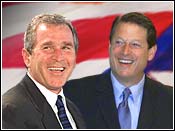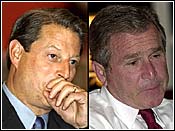
 On Nov. 7, 2000, after almost two years of campaign hype1 and money, over 90 million Americans will vote for the presidential candidates. On Dec. 18, 2000 the president and vice president of the United States will finally be elected2 by the votes of only 538 citizens - the "electors" of the Electoral College.
On Nov. 7, 2000, after almost two years of campaign hype1 and money, over 90 million Americans will vote for the presidential candidates. On Dec. 18, 2000 the president and vice president of the United States will finally be elected2 by the votes of only 538 citizens - the "electors" of the Electoral College.
How the Electoral College Elects the President
Isn't There a Problem Here?
 When you vote for a presidential candidate on Nov. 7, you will really be voting to instruct3 the electors from your state to cast4 their votes for the same candidate. For example, if you vote for the Republican candidate, you are really voting for an elector who will be "pledged5" to vote for the Republican candidate. The candidate who wins the popular vote in a state wins all the pledged votes of the state's electors.
When you vote for a presidential candidate on Nov. 7, you will really be voting to instruct3 the electors from your state to cast4 their votes for the same candidate. For example, if you vote for the Republican candidate, you are really voting for an elector who will be "pledged5" to vote for the Republican candidate. The candidate who wins the popular vote in a state wins all the pledged votes of the state's electors.
 The Electoral College system was established in Article II of the Constitution and amended6 by the 12th Amendment in 1804.
The Electoral College system was established in Article II of the Constitution and amended6 by the 12th Amendment in 1804.
 Each state gets a number of electors equal to its number of members in the U.S. House of Representatives7 plus one for each of its two U.S. Senators. The District of Columbia gets three electors. While state laws determine how electors are chosen, they are generally selected by the political party committees8 within the states.
Each state gets a number of electors equal to its number of members in the U.S. House of Representatives7 plus one for each of its two U.S. Senators. The District of Columbia gets three electors. While state laws determine how electors are chosen, they are generally selected by the political party committees8 within the states.
 Each elector gets one vote. Thus, a state with eight electors would cast eight votes. There are currently 538 electors and the votes of a majority of them - 270 votes - are required to be elected. Since Electoral College representation is based on congressional representation, states with larger populations get more Electoral College votes.
Each elector gets one vote. Thus, a state with eight electors would cast eight votes. There are currently 538 electors and the votes of a majority of them - 270 votes - are required to be elected. Since Electoral College representation is based on congressional representation, states with larger populations get more Electoral College votes.

 Should none of the candidates win 270 electoral votes, the 12th Amendment kicks in9 and the election is decided by the House of Representatives. The combined representatives of each state get one vote and a simple majority of states is required to win. This has only happened twice. Presidents Thomas Jefferson in 1801 and John Quincy Adams in 1825 were elected by the House of Representatives.
Should none of the candidates win 270 electoral votes, the 12th Amendment kicks in9 and the election is decided by the House of Representatives. The combined representatives of each state get one vote and a simple majority of states is required to win. This has only happened twice. Presidents Thomas Jefferson in 1801 and John Quincy Adams in 1825 were elected by the House of Representatives.
 While the state electors are "pledged" to vote for the candidate of the party that chose them, nothing in the Constitution requires them to do so. In rare instances, an elector will defect10 and not vote for his or her party's candidate. Such "faithless11" votes rarely change the outcome of the election and laws of some states prohibit electors from casting them.
While the state electors are "pledged" to vote for the candidate of the party that chose them, nothing in the Constitution requires them to do so. In rare instances, an elector will defect10 and not vote for his or her party's candidate. Such "faithless11" votes rarely change the outcome of the election and laws of some states prohibit electors from casting them.
 So we will all go vote on Tuesday, Nov. 7, and before the sun sets12 in California at least one of the TV networks will have declared a winner. By midnight, one of the candidates will have probably claimed13 victory and some will have conceded14 defeat. But not until the first Monday after the second Wednesday in December (Dec. 18, 2000), when the electors of the Electoral College meet in their state capitals and cast their votes will we really have a new president and vice president elect.
So we will all go vote on Tuesday, Nov. 7, and before the sun sets12 in California at least one of the TV networks will have declared a winner. By midnight, one of the candidates will have probably claimed13 victory and some will have conceded14 defeat. But not until the first Monday after the second Wednesday in December (Dec. 18, 2000), when the electors of the Electoral College meet in their state capitals and cast their votes will we really have a new president and vice president elect.
 Why the delay (42 days this year) between the general election and the Electoral College meetings? Back in the 1800s, it simply took that long to count the popular votes and for all the electors to travel to the state capitals. Today, the time is more likely to be used for settling15 any protests due to election code violations and for vote recounts.
Why the delay (42 days this year) between the general election and the Electoral College meetings? Back in the 1800s, it simply took that long to count the popular votes and for all the electors to travel to the state capitals. Today, the time is more likely to be used for settling15 any protests due to election code violations and for vote recounts.
 Critics of the Electoral College system, of which there are more than a few, point out that the system allows the possibility of a candidate actually losing the nationwide popular vote, but being elected president by the electoral vote. Can that happen? Yes, and it has.
Critics of the Electoral College system, of which there are more than a few, point out that the system allows the possibility of a candidate actually losing the nationwide popular vote, but being elected president by the electoral vote. Can that happen? Yes, and it has.